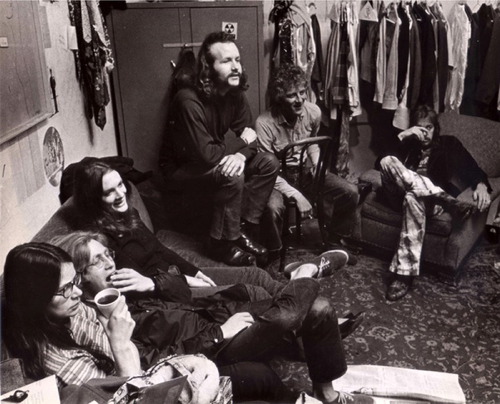Welcome to Part II of my super-cool article on the style of American Graffiti where, we look at, and over-analyze, the structural elements that make this film so special.
_______________________________________________________________
DOCUMENTARY STYLE: LONG LENSES
 |
| George & Marcia Lucas, & Co-Producer, Gary Kurtz |
Words like “naturalistic” and “documentary-like" are often used to
describe the style of American Graffiti.
In a documentary style the camera is often placed at a distance so it
doesn’t interfere with the subject being filmed. Many believe Graffiti’s “docu-style” to be a direct
reflection of Lucas’ own personality. “George is more aloof, he’s more private
and you can see that in his movies,” says Graffiti co-writer, Williard Huyuck. Due to shyness and lack of social
skills, it was easier for Lucas to stand back and let the camera capture
whatever happened between the actors rather than to directly tell them what he
wanted. “George started out as a documentary filmmaker with long lenses,” Huyuck
says, “and with long lenses you don’t have to get that close to the
subject.” Graffiti co-producer
Gary Kurtz agrees, “George came out of a documentary film background. His style was to shoot a lot of footage
and sit in the editing room and put it all together.”
For the reserved director, manipulating film was more desirable than manipulating an entire cast and crew. Although the feature took just four weeks to film, it took six months after filming was completed to edit the movie down to a manageable size. With the assistance of film editor Verna Fields and wife Marcia Lucas (also a professional film editor), Mr. Lucas managed to make the first cut of Graffiti an enormous three hours in length. Therefore, a lot of trimming was required to shorten the length and still really define and make the movie that Lucas wanted.
NOSTALGIA
 |
| Vietnam-era poster circa 1967 |
Had it really only been eleven years? The nostalgia it evoked worked to elude viewers of the turbulent social problems of the early 70s. At least for an hour and a half. In comparison to the more aggressive counter culture of the 60s, the teenagers in 50s were less threatening and basically harmless. Film goers delighted in experiencing and remembering a time when things seemed less complicated. Audiences loved it and most reviewers raved about the film. "The warmest, most human comedy in a long time...masterfully executed...profoundly affecting...sensationally funny," wrote Charles Champlin of the L.A. TIMES
 |
| Jana Bellan as Budda |
Although most critics loved American Graffiti some critics such as the influential Pauline Kael of THE NEW YORKER Magazine (1968-91), believed the film to be sexist. For instance, she pointed out that although the film tells what happened to each of the four male characters, viewers learn nothing about the fate of the girls at the end of the film. Ms. Kael refers to the the wonderful, bitter sweet postscript that is used as a re-affirmation that things change and to put the film in perspective. For clarity and balance it only makes sense that because the story begins with four white boys growing up in a small town in the early sixties that the story should also end with the focus on the same four protagonists. And, even though Ms. Kael has a valid point, Cindy Williams, who played Laurie in the film, defends Lucas' choice to only include the four young men in the end titles, poignantly stating, "It smacks of the times." And, indeed it did. Housekeeping and raising a family were considered ideal female roles in 1962. Those women that did work outside the home had yet to attain any position of influence: about 70 percent held clerical, assembly-line or service jobs in the latter part of the 1950s and early 1960s. Suburban values were sexist so, the film is consistent for a story about that year.
WOMEN INSIGHT THE ACTION
And, Toad wouldn't be nearly as funny if he wasn't trying to impress and win the affection of Debbie by feeding her lines such as, "I used to have a couple of horses myself. I used them for hunting. I do a lot of hunting. Deer mostly, although I got a couple of bear last year. Yep, they were good ponies-hunting ponies. I had to train 'em special, you know." Other clear examples of women initiating action in the film include Carol encouraging John to stop and vandalize a car full of girls, and Curt chasing a mysterious blonde all over town. And, ultimately Laurie shows she has the upper-hand in the relationship by manipulating Steve to stay in town with her rather than leave for college back east with her brother, Curt.'
"The whole film is essentially a teenage fantasy. It's purposely done that the kids get the better of the authority figures. How often do you really get the better of an adult when you're a kid?" -George Lucas
FINAL THOUGHTS
 |
| Saying goodbye to an era. |
moment, as Curt looks lost in thought, perhaps worried about the changes that lie ahead along with the realization that things will never be the same.
With Graffiti, Lucas created a comprehensive portrait of an entire era. In less than two hours, the viewer is given a glimpse into the golden age and a world that was about to change forever. The '60s would usher in the free speech movement, the growing anti-Vietnam sentiment and a whole counter-culture bringing with it all sorts of mayhem . Through the use of meticulous details such as clothing styles, hot-rods and drive-in waitresses on roller skates viewers get a feel for the 50s and a way of life that still reverberates in the memory of many Americans.

























